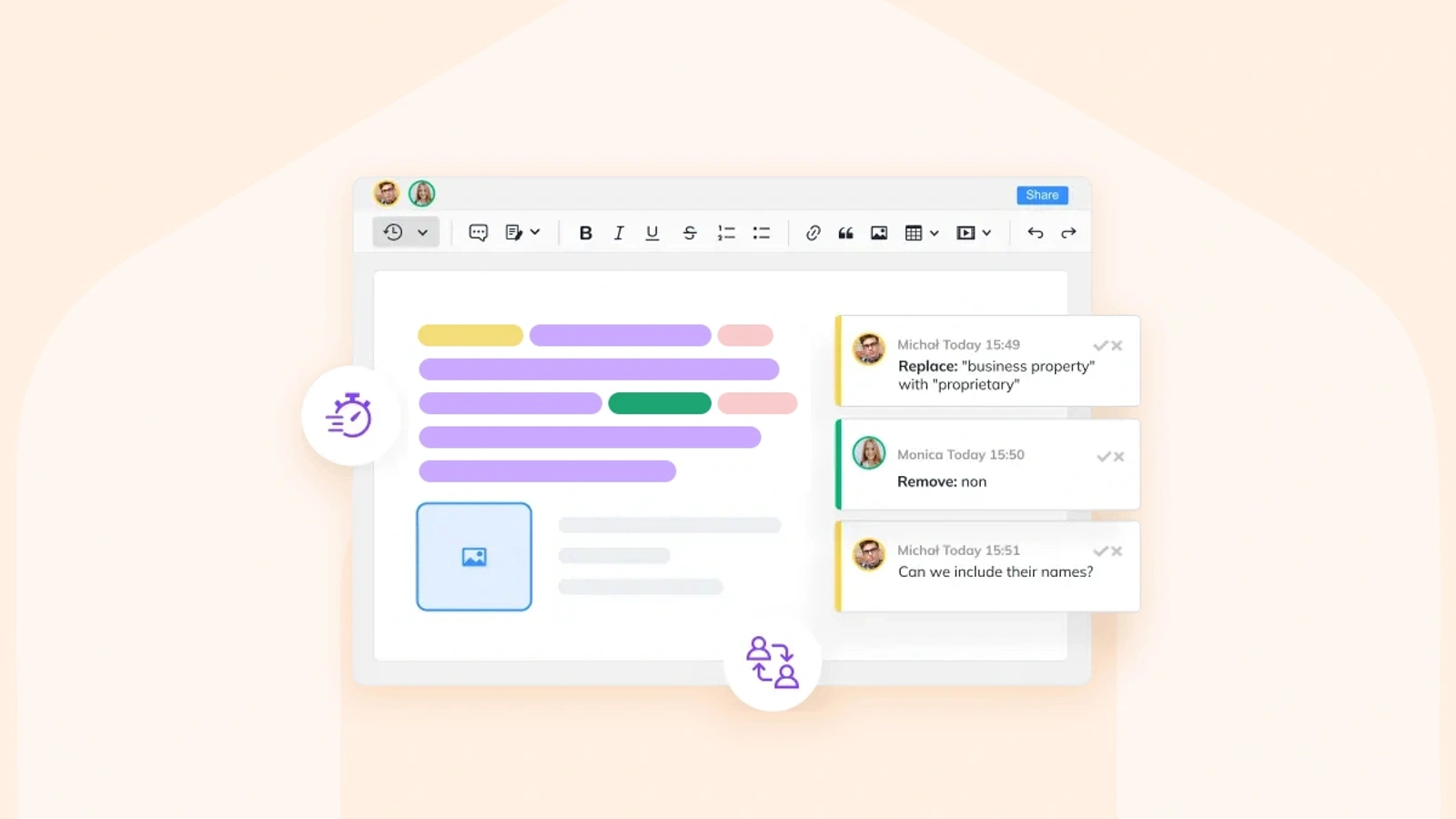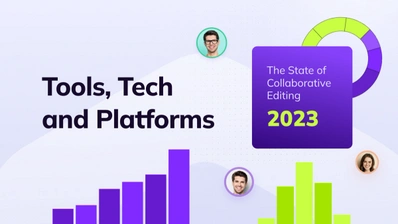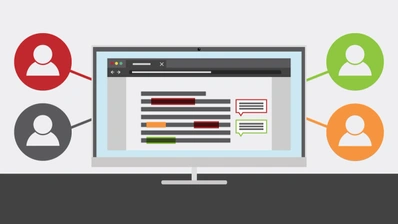Collaborative eLearning: Overcoming challenges and harnessing technology

The recent shift to remote work has been accompanied by a similar shift towards eLearning, at schools and workplaces alike. Just as hybrid work can lead to productivity boosts and better work-life balance, collaborative eLearning has the potential to transform the way education works. Sadly, most learning management systems (LMSs) aren’t fully equipped to get the benefits of collaborative learning, leading to worse outcomes for both teachers and students.
In 2020, the US saw record levels of enrollment in online learning courses, and the trend only intensified in subsequent years. A McKinsey study showed 69% of companies are investing more heavily in skill building and training than they were prior to the pandemic. Given the permanent move to hybrid and remote work, the bulk of that reskilling involves eLearning. So perhaps it’s no surprise that eLearning has become a big business, estimated to be worth as much as $350 billion by 2025.
Although business is booming, not all LMS platforms know how to leverage the advantages of their medium. While companies and classrooms have switched to eLearning to better respond to people’s needs, the tools they rely on aren’t optimized for social interaction, real-time discussion or teamwork. As a result, online learning risks lower engagement, worse information retention, and poor results.
So how can we make sure online learners get the best experience? The solution is to focus on collaboration – and the technology that makes it possible.
What is eLearning?
Basically, eLearning is any approach to education which uses computers or digital technology as the platform for teaching. Massively open online courses (MOOCs) are a popular form of eLearning, along with virtual classrooms and Zoom classes.
But eLearning as an idea dates back to the early 1700s. Back then it was called distance education, and it was a system of mailed correspondence between teachers of shorthand and interested students. Although the computer was still a couple of centuries away, the principle was the same as modern eLearning – using the best technology of the day to help students learn new skills. In 1999, corporate learning analyst Elliott Masie publicly coined the term eLearning to describe new possibilities for education and technology.
Technology on its own is no solution
Despite championing eLearning, Masie was no techno-utopian. He was quick to point out the dangers of treating new technology as a silver bullet solution instead of a tool for change. As Masie himself put it:
People think of the ‘E’ in eLearning as ‘electronic’. And certainly it’s electronic. But here’s a few more E’s – Everywhere learning, Everyday learning, Engaging learning, Evolving learning…
In other words, focusing on the technology itself instead of the new types of learning it can enable is the wrong way to look at eLearning. In subsequent years, Masie has emphasized that it’s the “learning” that’s the most important part of eLearning. He’s also come to focus on the benefits of collaborative learning approaches that rely on discussion and social interaction.
What are the benefits of collaborative eLearning?
Collaborative eLearning is an educational approach where online learning is conducted with two or more students. Unlike the old distance education-inspired model of individual students getting individual feedback from instructors, collaborative eLearning is geared more towards the kind of interactions that happen in a physical classroom. Think of activities such as pair work, team projects, and discussion groups.
There are a number of benefits of collaborative learning, including improved retention, reduced anxiety, and bolstered motivation. Collaborative learning, online or otherwise, has also been linked to the development of soft skills, a better understanding of diversity, and an increase in students’ ownership of, and investment in, their education.
Of course, collaborative eLearning has a range of applications beyond educational institutions. Coaching, training, and onboarding are vital components of any successful workplace, and businesses are increasingly taking these activities online. Learning remotely with colleagues brings greater flexibility and reduced stress.
Challenges of collaborative eLearning
Despite the great results, the major challenge of collaborative eLearning today is a fairly fundamental one: actually implementing it. eLearning has boomed since the pandemic, with an OECD report showing a significant increase in adult participation in online learning. Yet, as many parents can tell you, the sudden switch to eLearning hasn’t gone smoothly.
At schools and universities, the challenges of collaborative eLearning became all too clear as instructors rushed to move course content online, using systems like Brightspace, Zoom, and Canvas. For many, the shift had a negative impact on students’ overall social, emotional, and academic well-being. In particular, students had lower course completion rates, reduced enjoyment in educational activities, and just spent less time learning in general.
The problem was that no one had time to convert their lesson plans and activities to maximize the potential of eLearning. Instead, the learning environment was forced to fit into an LMS platform that didn’t even support effective collaborative learning. So, given eLearning isn’t going anywhere, how can we avoid running into these same pitfalls in the future?
3 key factors for successful collaborative eLearning
Unfortunately, most eLearning tools are still based around the distance education model of one-to-one instruction rather than Elliott Masie’s more engaging, collaborative ideal. Although LMS platforms present themselves as digital classrooms, many simply replicate the bare bones of a classroom – a whiteboard, a repository of course content, a place to submit assignments – without any thought for what’s missing.
There are three key factors a learning environment needs to be successful:
1. Social interaction
By focusing on content delivery and assessment, traditional LMS platforms leave social interaction between students or colleagues as an afterthought. But socializing isn’t just important for building camaraderie – it’s crucial to collaborative learning. Deloitte has found that 80% of workplace learning happens during social interactions with colleagues and managers.
As such, LMSs that implement robust, extensive social features are bound to foster a more compelling eLearning experience. For best results, the interaction needs to be connected to the work being done. A 30-person video call with everyone talking at once won’t help you learn. Tools such as comments and mentions, which allow peers to review each other’s work and leave questions, are crucial, as they create a environment of collaboration not competition.
Instructor feedback isn’t the only kind that matters, either. Peer review – by using track changes to suggest edits to a colleague’s work, for example – gives everyone involved a chance to understand the content better.
2. Real-time discussion
Discussing lessons in real-time is a major part of in-person learning. Studies show that students benefit from communicating with peers about course content, whether explaining thorny problems to each other or building on each other’s ideas. McKinsey has found that 20% of people say their biggest frustration with eLearning is the difficulty of engaging in real-time conversations.
While some LMSs have web-based forums for class discussions, these are designed for asynchronous communication, rather than real-time conversation. A carefully managed video call can facilitate discussion, but they create a significant participation barrier for anyone uncomfortable with speaking to the whole group.
A better option is to bring real-time communication tools into the LMS itself, and tie it to the course work. Allowing students to mention each other in comments and respond in real time to peer feedback on their work closely replicates the small-scale side conversations between peers and neighbors in a physical classroom. Unlike a classroom conversation, there’s a full record of each interaction, so the instructor can correct any misunderstandings and ensure conversations stay on-topic.
3. Teamwork
It almost goes without saying: a platform that can’t support group work can’t support collaborative eLearning. Students need to be able to work together on tasks to unlock all the benefits of collaborative learning. Tools which increase social interaction and real-time discussion also support teamwork. But the most important feature for truly collaborative work is simultaneous editing in real time.
Being able to work on the same document together, while keeping track of each teammate’s contribution, creates a collaborative group dynamic. With the possibility for so many changes to happen unnoticed, version history is a natural companion feature to ensure no work is lost. If seamless collaboration isn’t built into your LMS, you risk students moving to platforms such as Google Docs, with less oversight – or worse, becoming frustrated and disengaged.
These three things are essential for a collaborative eLearning platform to be effective. But how do you implement them successfully?
Add collaboration to your LMS via a modern rich text editor
Collaboration features crucial to the success of your LMS should be implemented at the most fundamental level. The rich text editor in your LMS is one of the most commonly used components by students and teachers alike. And yet, many LMSs use old-fashioned rich text editors that lack even a user-friendly editing interface, let alone collaboration features.
So it’s no wonder 18% of online learners say their top frustration is simply “getting the technology to work.” Switching to a rich text editor with a familiar, Google Docs-style interface solves this problem and puts collaborative eLearning at the heart of your LMS.
CKEditor is a modern WYSIWYG editor purpose-built for collaboration. Integrating CKEditor into your LMS enables social interaction and real-time discussion through features like Comments and Mentions directly in the editor itself. Teamwork is much more convenient with CKEditor’s leading-edge collaboration features. Real-time simultaneous editing means groups can work on the same content together inside your LMS, while Track Changes lets peers suggest changes to a teammate’s work, and Revision History keeps track of all the document versions, so nothing gets lost.
CKEditor Commercial Licence plans include a 14-day free trial and provide access to premium plugins, such as collaboration tools like Comments, Track Changes, and Revision History, as well as productivity features including Templates, Slash Commands, and more.
To learn more about making your LMS more collaborative and more effective, contact us today.


